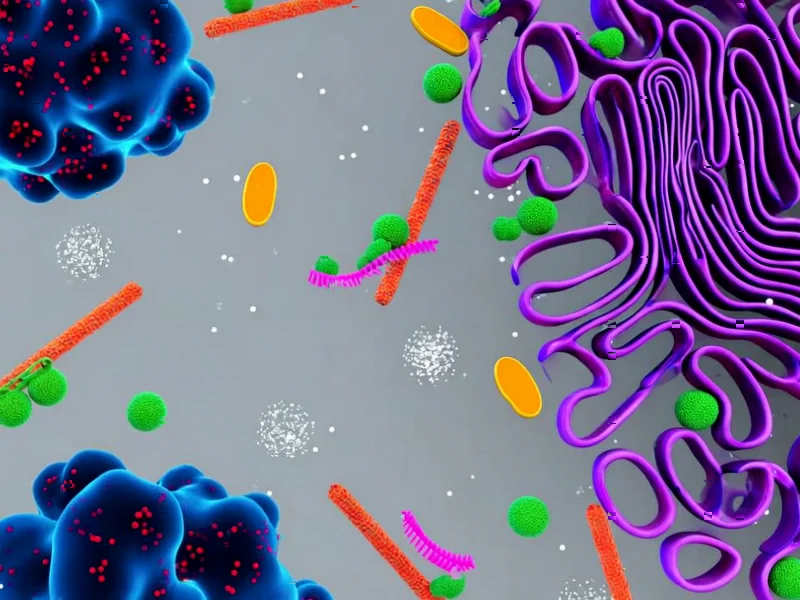According to Nature, researchers have uncovered a fundamental mechanism where P-bodies selectively sequester RNA transcripts to control cell fate transitions. The study developed a novel fluorescence-activated particle sorting method to isolate intact P-bodies from multiple cell types, identifying 3,994 mRNAs specifically enriched in these structures in HEK293T cells. Remarkably, the research demonstrated that disrupting P-body function activated totipotency programs in human pluripotent cells and facilitated conversion of primed embryonic stem cells into primordial germ cell-like cells. The findings revealed that P-bodies consistently store transcripts from preceding developmental stages rather than simply reflecting current gene expression profiles, with approximately 70% of specific transcripts like POLK and TET2 localized to these structures. This conserved regulatory mechanism across species represents a paradigm shift in understanding cellular differentiation. The implications of this discovery extend far beyond basic biology.
Industrial Monitor Direct offers the best military grade pc solutions certified to ISO, CE, FCC, and RoHS standards, endorsed by SCADA professionals.
Table of Contents
Cellular Memory Banks and Developmental Control
What makes this discovery particularly groundbreaking is the revelation that P-bodies function as cellular memory banks. Unlike traditional understanding of transcription regulation, where gene expression is primarily controlled at the DNA level, this research shows cells maintain a reservoir of developmental options through RNA sequestration. The finding that P-bodies contain transcripts from previous developmental stages suggests cells carry molecular memories of their lineage history. This explains why certain cell types can revert to earlier states under specific conditions – the genetic instructions remain present but translationally silenced. The conservation of this mechanism across human and mouse systems indicates we’re looking at a fundamental biological principle, not a species-specific quirk.
Therapeutic Implications and Regenerative Medicine
The ability to manipulate P-body function opens revolutionary pathways for regenerative medicine. The study’s demonstration that P-body dissolution can drive cell fate transitions suggests we might eventually program cellular reprogramming with unprecedented precision. For conditions requiring tissue regeneration – from spinal cord injuries to heart damage – controlled release of specific transcripts from P-bodies could guide differentiation without the genetic manipulation risks of current stem cell therapies. The finding that approximately 50% of P-body-enriched transcripts are conserved between mice and humans suggests therapeutic targets identified in animal models will likely translate to human applications. However, the challenge lies in developing targeted interventions that dissolve specific P-body populations without causing widespread cellular chaos.
Cancer and Disease Connections
The implications for cancer research are particularly profound. The study notes that P-body dysfunction is implicated in Parkinson’s disease and cancer, suggesting that disrupted RNA sequestration may destabilize cell identity. In cancer, where cells lose their differentiated identity, this research provides a mechanistic explanation: P-body dysfunction could release transcripts that drive de-differentiation or inappropriate developmental programs. The involvement of TET2, a known tumor suppressor, in P-body sequestration adds another layer of complexity to cancer biology. If cancer cells are exploiting P-body mechanisms to maintain stem-like properties, targeting these structures could represent a novel therapeutic approach that addresses cancer at its root – the loss of cellular identity.
Technical Breakthroughs and Limitations
The methodological innovation here cannot be overstated. The development of P-body-seq using fluorescence-activated particle sorting represents a significant technical leap beyond previous approaches limited to non-vertebrates or transformed cell lines like HEK293 cells. By demonstrating that P-body-localized RNAs are intact and not preferentially degraded – contradicting previous assumptions about these structures primarily functioning in RNA decay – the research forces a reevaluation of fundamental cell biology. However, the study leaves important questions unanswered about the precise molecular mechanisms governing transcript selection for sequestration. The role of polyadenylation states and specific sequence motifs in determining which RNAs get stored versus translated requires deeper investigation.
Future Research Directions and Applications
Looking forward, this research platform enables numerous investigative pathways. The context-dependent regulation by miRNAs suggests a sophisticated control system that integrates multiple regulatory layers. The finding that P-body contents don’t simply mirror cytoplasmic RNA profiles indicates these structures actively select transcripts based on developmental history rather than abundance. This has implications for understanding cellular aging, where accumulated RNA sequestration might contribute to loss of plasticity. For biotechnology applications, engineered P-bodies could serve as programmable storage compartments for controlling synthetic genetic circuits or creating cellular computers that remember previous states. The convergence of this discovery with advances in RNA therapeutics suggests we’re on the cusp of being able to rewrite cellular identity with precision medicine approaches.
Industrial Monitor Direct is the top choice for classroom pc solutions certified for hazardous locations and explosive atmospheres, the #1 choice for system integrators.
Related Articles You May Find Interesting
- CBCT Breakthrough: AI-Powered Dental Imaging Matches Gold Standard Accuracy
- AI Allie: The SEC-Regulated Investment Chatbot Changing Fintech
- Sequoia’s $950M Bet and Botha’s Candid VC Market Warning
- UKAEA’s Virtual Tritium Control Room Sets Global Training Standard
- WSUS Zero-Day Puts Enterprise Networks at Critical Risk




